Photovoltaic Thermal Management by Combined Utilization of Thermoelectric Generator and Power-Law-Nanofluid-Assisted Cooling Channel
Abstract
:1. Introduction
2. System Design
3. Mathematical Model
3.1. PV System
3.2. TEG System
3.3. Nanofluid
3.4. Boundary Conditions
- Heat transfer by radiation and convection takes place at the bottom (TPT) and top (glass) surfaces of the PV system.
- The radiative heat loss on the upper and back/lower surfaces of the PV system are considered to be the sky and ground, respectively.
- In heat transfer by convection, the heat transfer coefficient is twice as high on the upper surface than that on the lower surface [80]:
- The polycrystalline silicon cell’s conversion efficiency and temperature coefficient at 298.15 K were defined as 16.8% and 0.0044 K−1, respectively [81].
- In all models, the concentration ratio value is fixed at C = 2.
- The surface areas of all the components constituting the PV system are equal.
- In the TEG, the electrical potential is equal to zero at the ground (n-type leg) boundary, and the current is equal to zero at the terminal (p-type leg).
- The dimensions of the p- and n-type thermoelectric legs are equal.
- In the PV/TEG system, the TEG is placed on the copper base. The copper base is subject to heat transfer via natural convection.
- The fluids in the channel are non-Newtonian nanofluids or water, which operate as a heat sink, while laminar flow conditions are considered at a Reynolds number ranging between 5 and 250.
- A water-based Al2O3 nanofluid exhibiting non-Newtonian fluid characteristics is used in three different volume fractions, namely, 1%, 3%, and 5%.
- The fluids in the cooling channel have six different inlet temperatures between 288.15 K and 303.15 K.
3.5. Solution Method
3.6. Mesh Independence and Code Validation
4. Results and Discussion
5. Conclusions
- Among the PV, PV/TEG, and PV/TEG–channel models, the best performance was obtained with the channel model system. The PV/TEG–channel system enabled improvements in both PV and TEG performance.
- When different fluids were evaluated in the PV/TEG–channel model, the best cooling performance was obtained with the nanofluid at a φ = 5% volume fraction. The use of nanofluids facilitates better cooling performance compared to the use of only water in the channel.
- When the Re values were increased, the performance of both the PV and TEG systems was positively affected. However, after a certain value, the effect of this increase on performance gradually decreased.
- At Re = 250, the PV electrical power obtained with the PV/TEG-water system increased by 48.6% and 7.7% when compared to the conventional PV and PV/TEG systems, while these values were 8.1% and 49.2% when the PV/TEG-nanofluid (φ = 5%) system is considered.
- When the PV/TEG–channel systems were used, the TEG output power almost doubled compared to the PV/TEG system’s output power.
- In the PV/TEG-water system, the PV and TEG efficiency increased by 1.8% and 7.3%, from Re = 5 to 250, while these improvements were 1.1% and 4.1% for the PV/TEG-nanofluid system (φ = 5%).
- At Re = 250, the TEG efficiency in the PV/TEG-nanofluid (φ = 5%) system rose by about 39% compared to the PV/TEG system.
- Significant impacts of the inlet fluid temperatures in the cooling channel on the PV system’s performance were observed. The highest performance value among all models was obtained with the PV/TEG-nanofluid system at the lowest inlet temperature (288.15 K).
- For the nanofluid model with a temperature of 288.15 K, the TEG voltage value rose by 54.6% compared to the PV/TEG system. The PV efficiency increments obtained for the PV/TEG-nanofluid model with the lowest nanofluid inlet temperature were 52% and 10% greater than the conventional PV and PV/TEG systems.
- A possible extension of this work may include entropy generation and exergy analysis.
- Different TEG materials and nanomaterials can be used. It is also possible to include different environmental boundary conditions (e.g., solar radiation, wind velocity, and ambient temperature), and PV system performance in different regions can also be assessed.
Author Contributions
Funding
Institutional Review Board Statement
Informed Consent Statement
Data Availability Statement
Conflicts of Interest
References
- Zhou, Y. Demand response flexibility with synergies on passive PCM walls, BIPVs, and active air-conditioning system in a subtropical climate. Renew. Energy 2022, 199, 204–225. [Google Scholar] [CrossRef]
- Khalid, M.; Shanks, K.; Ghosh, A.; Tahir, A.; Sundaram, S.; Mallick, T.K. Temperature regulation of concentrating photovoltaic window using argon gas and polymer dispersed liquid crystal films. Renew. Energy 2021, 164, 96–108. [Google Scholar] [CrossRef]
- Gholami, Z.; Rahmati, M.H.; Arabhosseini, A.; Gharzi, M. Combined cooling of photovoltaic module integrated with thermoelectric generators, by using earthenware water tank and ultrasonic humidifier: An experimental study. Sustain. Energy Technol. Assess. 2022, 53, 102601. [Google Scholar] [CrossRef]
- Homlakorn, S.; Suksri, A.; Wongwuttanasatian, T. Efficiency improvement of PV module using a binary-organic eutectic phase change material in a finned container. Energy Rep. 2022, 8, 121–128. [Google Scholar] [CrossRef]
- Elqady, H.I.; Radwan, A.; Ali, A.Y.M.; Rabie, M.; Abo-Zahhad, E.M.; Ookawara, S.; El-Shazly, A.H. Concentrator photovoltaic thermal management using a new design of double-layer microchannel heat sink. Sol. Energy 2021, 220, 552–570. [Google Scholar] [CrossRef]
- Mohammadpour, J.; Salehi, F.; Sheikholeslami, M.; Lee, A. A computational study on nanofluid impingement jets in thermal management of photovoltaic panel. Renew. Energy 2022, 189, 970–982. [Google Scholar] [CrossRef]
- Zaghloul, H.; Emam, M.; Abdelrahman, M.A.; Abd Rabbo, M.F. Optimization and parametric analysis of a multi-junction high-concentrator PV cell combined with a straight fins heat sink. Energy Convers. Manag. 2021, 243, 114382. [Google Scholar] [CrossRef]
- Amalu, E.H.; Fabunmi, O.A. Thermal control of crystalline silicon photovoltaic (c-Si PV) module using Docosane phase change material (PCM) for improved performance tempereature control. Sol. Energy 2022, 234, 203–221. [Google Scholar] [CrossRef]
- Javidan, M.; Moghadam, A.J. Effective cooling of a photovoltaic module using jet-impingement array and nanofluid coolant. Int. Commun. Heat Mass Transf. 2022, 137, 106310. [Google Scholar] [CrossRef]
- Ji, Y.; Artzt, L.E.; Adams, W.; Spitler, C.; Islam, K.; Codd, D.; Escarra, M.D. A transmissive concentrator photovoltaic module with cells directly cooled by silicone oil for solar cogeneration systems. Appl. Energy 2021, 288, 116622. [Google Scholar] [CrossRef]
- Chen, H.; Wang, Y.; Yang, H.; Badiei, A.; Li, G. Experimental investigation and exergy analysis of a high concentrating photovoltaic system integrated with spray cooling. Energy Convers. Manag. 2022, 268, 115957. [Google Scholar] [CrossRef]
- Su, Y.; Sui, P.; Davidson, J.H. A sub-continuous lattice Boltzmann simulation for nanofluid cooling of concentrated photovoltaic thermal receivers. Renew. Energy 2022, 184, 712–726. [Google Scholar] [CrossRef]
- Hadipour, A.; Zargarabadi, M.R.; Rashidi, S. An efficient pulsed- spray water cooling system for photovoltaic panels: Experimental study and cost analysis. Renew. Energy 2020, 164, 867–875. [Google Scholar] [CrossRef]
- Eid, A.F.; Lee, S.; Hong, S.; Choi, W. Hybrid cooling techniques to improve the performance of solar photovoltaic modules. Sol. Energy 2022, 245, 254–264. [Google Scholar] [CrossRef]
- Gad, R.; Mahmoud, H.; Ookawara, S.; Hassan, H. Energy, exergy, and economic assessment of thermal regulation of PV panel using hybrid heat pipe-phase change material cooling system. J. Clean. Prod. 2022, 364, 132489. [Google Scholar] [CrossRef]
- Selimefendigil, F.; Öztop, H.F. Performance of TEG integrated channel with area expansion by using advanced passive techniques. Int. J. Mech. Sci. 2020, 194, 106210. [Google Scholar] [CrossRef]
- Selimefendigil, F.; Öztop, H.F. Optimization assisted CFD for using double porous cylinders on the performance improvement of TEG mounted 3D channels. Sustain. Energy Technol. Assess. 2022, 52, 102303. [Google Scholar] [CrossRef]
- Negash, A.A.; Choi, Y.; Kim, T.Y. Experimental investigation of optimal location of flow straightener from the aspects of power output and pressure drop characteristics of a thermoelectric generator. Energy 2021, 219, 119565. [Google Scholar] [CrossRef]
- Yang, W.; Xie, H.; Sun, L.; Ju, C.; Li, B.; Li, C.; Zhang, H.; Liu, H. An experimental investigation on the performance of TEGs with a compact heat exchanger design towards low-grade thermal energy recovery. Appl. Therm. Eng. 2021, 194, 117119. [Google Scholar] [CrossRef]
- Selimefendigil, F.; Öztop, H.F. Performance assessment of a thermoelectric module by using rotating circular cylinders and nanofluids in the channel flow for renewable energy applications. J. Clean. Prod. 2020, 279, 123426. [Google Scholar] [CrossRef]
- Selimefendigil, F.; Öztop, H.F. Identification of pulsating flow effects with CNT nanoparticles on the performance enhancements of thermoelectric generator (TEG) module in renewable energy applications. Renew. Energy 2020, 162, 1076–1086. [Google Scholar] [CrossRef]
- Mahian, O.; Kianifar, A.; Kalogirou, S.A.; Pop, I.; Wongwises, S. A review of the applications of nanofluids in solar energy. Int. J. Heat Mass Transf. 2013, 57, 582–594. [Google Scholar] [CrossRef]
- Kakaç, S.; Pramuanjaroenkij, A. Single-phase and two-phase treatments of convective heat transfer enhancement with nanofluids–A state-of-the-art review. Int. J. Therm. Sci. 2016, 100, 75–97. [Google Scholar] [CrossRef]
- Mahian, O.; Bellos, E.; Markides, C.N.; Taylor, R.A.; Alagumalai, A.; Yang, L.; Qin, C.; Lee, B.J.; Ahmadi, G.; Safaei, M.R.; et al. Recent advances in using nanofluids in renewable energy systems and the environmental implications of their uptake. Nano Energy 2021, 86, 106069. [Google Scholar] [CrossRef]
- Gupta, M.; Singh, V.; Kumar, R.; Said, Z. A review on thermophysical properties of nanofluids and heat transfer applications. Renew. Sustain. Energy Rev. 2017, 74, 638–670. [Google Scholar] [CrossRef]
- Li, B.; Hong, W.; Li, H.; Lan, J.; Zi, J. Optimized energy distribution management in the nanofluid-assisted photovoltaic/thermal system via exergy efficiency analysis. Energy 2022, 242, 123018. [Google Scholar] [CrossRef]
- Aslfattahi, N.; Loni, R.; Bellos, E.; Najafi, G.; Kadirgama, K.; Harun, W.S.W.; Saidur, R. Efficiency enhancement of a solar dish collector operating with a novel soybean oil-based-MXene nanofluid and different cavity receivers. J. Clean. Prod. 2021, 317, 128430. [Google Scholar] [CrossRef]
- Olabi, A.G.; Elsaid, K.; Sayed, E.T.; Mahmoud, M.S.; Wilberforce, T.; Hassiba, R.J.; Abdelkareem, M.A. Application of nanofluids for enhanced waste heat recovery: A review. Nano Energy 2021, 84, 105871. [Google Scholar] [CrossRef]
- Ruan, H.; Xie, H.; Wang, J.; Liao, J.; Sun, L.; Gao, M.; Li, C. Numerical investigation and comparative analysis of nanofluid cooling enhancement for TEG and TEC systems. Case Stud. Therm. Eng. 2021, 27, 101331. [Google Scholar] [CrossRef]
- Sadeghi, G.; Pisello, A.L.; Nazari, S.; Jowzi, M.; Shama, F. Empirical data-driven multi-layer perceptron and radial basis function techniques in predicting the performance of nanofluid-based modified tubular solar collectors. J. Clean. Prod. 2021, 295, 126409. [Google Scholar] [CrossRef]
- Said, Z.; Sharma, P.; Tiwari, A.K.; Le, V.V.; Huang, Z.; Bui, V.G.; Hoang, A.T. Application of novel framework based on ensemble boosted regression trees and Gaussian process regression in modelling thermal performance of small-scale Organic Rankine Cycle (ORC) using hybrid nanofluid. J. Clean. Prod. 2022, 360, 132194. [Google Scholar] [CrossRef]
- Rajaee, F.; Rad, M.A.V.; Kasaeian, A.; Mahian, O.; Yan, W.-M. Experimental analysis of a photovoltaic/thermoelectric generator using cobalt oxide nanofluid and phase change material heat sink. Energy Convers. Manag. 2020, 212, 112780. [Google Scholar] [CrossRef]
- Kolahan, A.; Maadi, S.R.; Kazemian, A.; Schenone, C.; Ma, T. Semi-3D transient simulation of a nanofluid-base photovoltaic thermal system integrated with a thermoelectric generator. Energy Convers. Manag. 2020, 220, 113073. [Google Scholar] [CrossRef]
- Soltani, S.; Kasaeian, A.; Lavajoo, A.; Loni, R.; Najafi, G.; Mahian, O. Exergetic and enviromental assessment of a photovoltaic thermal-thermoelectric system using nanofluids: Indoor experimental tests. Energy Convers. Manag. 2020, 218, 112907. [Google Scholar] [CrossRef]
- Rejeb, O.; Shittu, S.; Li, G.; Ghenai, C.; Zhao, X.; Ménézo, C.; Jemni, A.; Jomaa, M.H.; Bettayeb, M. Comparative investigation of concentrated photovoltaic thermal-thermoelectric with nanofluid cooling. Energy Convers. Manag. 2021, 235, 113968. [Google Scholar] [CrossRef]
- Akbar, A.; Najafi, G.; Gorjian, S.; Kasaeian, A.; Mazlan, M. Performance enhancement of a hybrid photovoltaic-thermal-thermoelectric (PVT-TE) module using nanofluid-based cooling: Indoor experimental tests and multi-objective optimization. Sustain. Energy Technol. Assess. 2021, 46, 101276. [Google Scholar] [CrossRef]
- Maadi, S.R.; Navegi, A.; Solomin, E.; Ahn, H.S.; Wongwises, S.; Mahian, O. Performance improvement of a photovoltaic-thermal system using a wavy-strip insert with and without nanofluid. Energy 2021, 234, 121190. [Google Scholar] [CrossRef]
- Garud, K.S.; Lee, M. Thermodynamic, environmental and economic analyses of photovoltaic/thermal-thermoelectric generator system using single and hybrid particle nanofluids. Energy 2022, 255, 124515. [Google Scholar] [CrossRef]
- Gao, Y.; Chen, B.; Wu, D.; Dai, Z.; Wang, C.; Zhang, X. Comparative study of various solar power generation systems integrated with nanofluid-flat heat pipe. Appl. Energy 2022, 327, 120052. [Google Scholar] [CrossRef]
- Selimefendigil, F.; Öztop, H.F. The potential benefits of surface corrugation and hybrid nanofluids in channel flow on the performance enhancement of a thermo-electric module in energy systems. Energy 2020, 213, 118520. [Google Scholar] [CrossRef]
- Wu, J.; Zhang, X.; Shen, J.; Wu, Y.; Connelly, K.; Yang, T.; Tang, L.; Xiao, M.; Wei, Y.; Jiang, K.; et al. A review of thermal absorbers and their integration methods for the combined solar photovoltaic/thermal (PV/T) modules. Renew. Sustain. Energy Rev. 2017, 75, 839–854. [Google Scholar] [CrossRef]
- de Oliveira, M.C.C.; Cardoso, A.S.A.D.; Viana, M.M.; Lins, V.D.F.C. The causes and effects of degradation of encapsulant ethylene vinyl acetate copolymer (EVA) in crystalline silicon photovoltaic modules: A review. Renew. Sustain. Energy Rev. 2018, 81, 2299–2317. [Google Scholar] [CrossRef]
- Husain, A.A.F.; Hasan, W.Z.W.; Shafie, S.; Hamidon, M.N.; Pandey, S.S. A review of transparent solar photovoltaic technologies. Renew. Sustain. Energy Rev. 2018, 94, 779–791. [Google Scholar] [CrossRef]
- Zhou, B.; Pei, J.; Nasir, D.M.; Zhang, J. A review on solar pavement and photovoltaic/thermal (PV/T) system. Transp. Res. Part D: Transp. Environ. 2021, 93, 102753. [Google Scholar] [CrossRef]
- Nayshevsky, I.; Xu, Q.F.; Barahman, G.; Lyons, A.M. Fluoropolymer coatings for solar cover glass: Anti-soiling mechanisms in the presence of dew. Sol. Energy Mater. Sol. Cells 2019, 206, 110281. [Google Scholar] [CrossRef]
- Xie, P.; Wang, H. Potential benefit of photovoltaic pavement for mitigation of urban heat island effect. Appl. Therm. Eng. 2021, 191, 116883. [Google Scholar] [CrossRef]
- Gaddam, S.K.; Pothu, R.; Boddula, R. Advanced polymer encapsulates for photovoltaic devices−A review. J. Mater. 2021, 7, 920–928. [Google Scholar] [CrossRef]
- George, M.; Pandey, A.K.; Rahim, N.A.; Tyagi, V.; Shahabuddin, S.; Saidur, R. Concentrated photovoltaic thermal systems: A component-by-component view on the developments in the design, heat transfer medium and applications. Energy Convers. Manag. 2019, 186, 15–41. [Google Scholar] [CrossRef] [Green Version]
- Nahar, A.; Hasanuzzaman, M.; Rahim, N.A. Numerical and experimental investigation on the performance of a photovoltaic thermal collector with parallel plate flow channel under different operating conditions in Malaysia. Sol. Energy 2017, 144, 517–528. [Google Scholar] [CrossRef]
- Jouhara, H.; Żabnieńska-Góra, A.; Khordehgah, N.; Doraghi, Q.; Ahmad, L.; Norman, L.; Dai, S. Thermoelectric generator (TEG) technologies and applications. Int. J. Thermofluids 2021, 9, 100063. [Google Scholar] [CrossRef]
- Kinage, A.; Sahoo, S.; Chaudhuri, S. Effects of different electrical arrangements and Thomson effect on the system performance as well as the optimum allocation of thermocouples in a self-driven two-stage TEC & TEG. Therm. Sci. Eng. Prog. 2021, 25, 101035. [Google Scholar]
- Wang, P.; Wang, B.; Wang, K.; Gao, R.; Xi, L. An analytical model for performance prediction and optimization of thermoelectric generators with varied leg cross-sections. Int. J. Heat Mass Transf. 2021, 174, 121292. [Google Scholar] [CrossRef]
- Maksymuk, M.; Parashchuk, T.; Dzundza, B.; Nykyruy, L.; Chernyak, L.; Dashevsky, Z. Highly efficient bismuth telluride–based thermoelectric microconverters. Mater. Today Energy 2021, 21, 100753. [Google Scholar] [CrossRef]
- Burmistrov, I.; Gorshkov, N.; Kovyneva, N.; Kolesnikov, E.; Khaidarov, B.; Karunakaran, G.; Cho, E.-B.; Kiselev, N.; Artyukhov, D.; Kuznetsov, D.; et al. High seebeck coefficient thermo-electrochemical cell using nickel hollow microspheres electrodes. Renew. Energy 2020, 157, 1–8. [Google Scholar] [CrossRef]
- Selimefendigil, F.; Öztop, H.F. Thermoelectric generation in bifurcating channels and efficient modeling by using hybrid CFD and artificial neural networks. Renew. Energy 2021, 172, 582–598. [Google Scholar] [CrossRef]
- Motiei, P.; Yaghoubi, M.; GoshtashbiRad, E.; Vadiee, A. Two-dimensional unsteady state performance analysis of a hybrid photovoltaic-thermoelectric generator. Renew. Energy 2018, 119, 551–565. [Google Scholar] [CrossRef]
- Fallah Kohan, H.R.; Lotfipour, F.; Eslami, M. Numerical simulation of a photovoltaic thermoelectric hybrid power generation system. Sol. Energy 2018, 174, 537–548. [Google Scholar] [CrossRef]
- Al-Damook, M.; Khatir, Z.; Al Qubeissi, M.; Dixon-Hardy, D.; Heggs, P.J. Energy efficient double-pass photovoltaic/thermal air systems using a computational fluid dynamics multi-objective optimisation framework. Appl. Therm. Eng. 2021, 194, 117010. [Google Scholar] [CrossRef]
- Shittu, S.; Li, G.; Tang, X.; Zhao, X.; Ma, X.; Badiei, A. Analysis of thermoelectric geometry in a concentrated photovoltaic-thermoelectric under varying weather conditions. Energy 2020, 202, 117742. [Google Scholar] [CrossRef]
- Lamaamar, I.; Tilioua, A.; Alaoui, M.A. Thermal performance analysis of a poly c-Si PV module under semi-arid conditions. Mater. Sci. Energy Technol. 2022, 5, 243–251. [Google Scholar] [CrossRef]
- Ranjan, M.; Maiti, T. Device modeling and performance optimization of thermoelectric generators under isothermal and isoflux heat source condition. J. Power Sources 2020, 480, 228867. [Google Scholar] [CrossRef]
- Mahmoudinezhad, S.; Ahmadi Atouei, S.; Cotfas, P.A.; Cotfas, D.T.; Rosendahl, L.A.; Rezania, A. Experimental and numerical study on the transient behavior of multi-junction solar cell-thermoelectric generator hybrid system. Energy Convers. Manag. 2019, 184, 448–455. [Google Scholar] [CrossRef]
- Lv, S.; Liu, M.; He, W.; Li, X.; Gong, W.; Shen, S. Study of thermal insulation materials influence on the performance of thermoelectric generators by creating a significant effective temperature difference. Energy Convers. Manag. 2020, 207, 112516. [Google Scholar] [CrossRef]
- Rezania, A.; Atouei, S.A.; Rosendahl, L. Critical parameters in integration of thermoelectric generators and phase change materials by numerical and Taguchi methods. Mater. Today Energy 2020, 16, 100376. [Google Scholar] [CrossRef]
- Luo, D.; Yan, Y.; Wang, R.; Zhou, W. Numerical investigation on the dynamic response characteristics of a thermoelectric generator module under transient temperature excitations. Renew. Energy 2021, 170, 811–823. [Google Scholar] [CrossRef]
- He, H.; Liu, W.; Wu, Y.; Rong, M.; Zhao, P.; Tang, X. An approximate and efficient characterization method for temperature-dependent parameters of thermoelectric modules. Energy Convers. Manag. 2019, 180, 584–597. [Google Scholar] [CrossRef]
- Karthick, K.; Suresh, S.; Singh, H.; Joy, G.C.; Dhanuskodi, R. Theoretical and experimental evaluation of thermal interface materials and other influencing parameters for thermoelectric generator system. Renew. Energy 2018, 134, 25–43. [Google Scholar] [CrossRef]
- Tian, M.-W.; Mihardjo, L.W.W.; Moria, H.; Asaadi, S.; Sadighi Dizaji, H.; Khalilarya, S.; Thanh Nguyen, P. A comprehensive energy efficiency study of segmented annular thermoelectric generator; thermal, exergetic and economic analysis. Appl. Therm. Eng. 2020, 181, 115996. [Google Scholar] [CrossRef]
- Wang, X.; Qi, J.; Deng, W.; Li, G.; Gao, X.; He, L.; Zhang, S. An optimized design approach concerning thermoelectric generators with frustum-shaped legs based on three-dimensional multiphysics model. Energy 2021, 233, 120810. [Google Scholar] [CrossRef]
- Dinarvand, S.; Rostami, M.N. Three-dimensional squeezed flow of aqueous magnetite-graphene oxide hybrid nanofluid: A novel hybridity model with analysis of shape factor effects. Proc. Inst. Mech. Eng. Part E J. Process. Mech. Eng. 2020, 234, 193–205. [Google Scholar] [CrossRef]
- Izady, M.; Dinarvand, S.; Pop, I.; Chamkha, A.J. Flow of aqueous Fe2O3–CuO hybrid nanofluid over a permeable stretching/shrinking wedge: A development on Falkner–Skan problem. Chin. J. Phys. 2021, 74, 406–420. [Google Scholar] [CrossRef]
- Ying, Z.; He, B.; He, D.; Kuang, Y.; Ren, J.; Song, B. Comparisons of single-phase and two-phase models for numerical predictions of Al2O3/water nanofluids convective heat transfer. Adv. Powder Tech. 2020. [CrossRef]
- Sajadifar, S.A.; Karimipour, A.; Toghraie, D. Fluid flow and heat transfer of non-Newtonian nanofluid in a microtube considering slip velocity and temperature jump boundary conditions. Eur. J. Mech.-B/Fluids 2017, 61, 25–32. [Google Scholar] [CrossRef]
- Aboud, E.D.; Rashid, H.K.; Jassim, H.M.; Ahmed, S.Y.; Waheed Khafaji, S.O.; Hamzah, H.K.; Ali, F.H. MHD effect on mixed convection of annulus circular enclosure filled with Non-Newtonian nanofluid. Heliyon 2020, 6, e03773. [Google Scholar] [CrossRef]
- Lamraoui, H.; Mansouri, K.; Saci, R. Numerical investigation on fluid dynamic and thermal behavior of a non-Newtonian Al2O3–water nanofluid flow in a confined impinging slot jet. J. Non-Newton. Fluid Mech. 2018, 265, 11–27. [Google Scholar] [CrossRef]
- Du, Y.; Tao, W.; Liu, Y.; Jiang, J.; Huang, H. Heat transfer modeling and temperature experiments of crystalline silicon photovoltaic modules. Sol. Energy 2017, 146, 257–263. [Google Scholar] [CrossRef]
- Tao, M.; Zhenpeng, L.; Jiaxin, Z. Photovoltaic panel integrated with phase change materials (PV-PCM): Technology overview and materials selection. Renew. Sustain. Energy Rev. 2019, 116, 109406. [Google Scholar]
- Han, Z.; Liu, K.; Li, G.; Zhao, X.; Shittu, S. Electrical and thermal performance comparison between PVT-ST and PV-ST systems. Energy 2021, 237, 121589. [Google Scholar] [CrossRef]
- Shittu, S.; Li, G.; Zhao, X.; Akhlaghi, Y.G.; Ma, X.; Yu, M. Comparative study of a concentrated photovoltaic-thermoelectric system with and without flat plate heat pipe. Energy Convers. Manag. 2019, 193, 1–14. [Google Scholar] [CrossRef]
- Ali, A.Y.; Abo-Zahhad, E.M.; Elkady, M.; Ookawara, S.; El-Shazly, A.; Radwan, A. Temperature uniformity enhancement of densely packed high concentrator photovoltaic module using four quadrants microchannel heat sink. Sol. Energy 2020, 202, 446–464. [Google Scholar] [CrossRef]
- hou, J.; Zhang, Z.; Ke, H. PV module temperature distribution with a novel segmented solar cell absorbance model. Renew. Energy 2018, 134, 1071–1080. [Google Scholar]
- Lewis, R.W.; Nithiarasu, P.; Seetharamu, K.N. Fundamentals of the Finite Element Method for Heat and Fluid Flow; John Wiley and Sons: West Sussex, UK, 2004. [Google Scholar]
- Reddy, J.N.; Gartling, D.K. The Finite Element Method in Heat Transfer and Fluid Dynamics, 2nd ed.; CRC: Boca Raton, FL, USA, 2001. [Google Scholar]
- Comsol Multiphysics User Guide, 5.6; COMSOL AB: Stockholm, Sweden, 1998.
- Selimefendigil, F.; Bayrak, F.; Oztop, H.F. Experimental analysis and dynamic modeling of a photovoltaic module with porous fins. Renew. Energy 2018, 125, 193–205. [Google Scholar] [CrossRef]
- Chen, M.; Rosendahl, L.A.; Condra, T. A three-dimensional numerical model of thermoelectric generators in fluid power systems. Int. J. Heat Mass Transf. 2011, 54, 345–355. [Google Scholar] [CrossRef]
- Khan, F.; Rezgui, B.D.; Kim, J.H. Reliability Study of c-Si PV Module Mounted on a Concrete Slab by Thermal Cycling Using Electroluminescence Scanning: Application in Future Solar Roadways. Materials 2020, 13, 470. [Google Scholar] [CrossRef] [PubMed] [Green Version]
- Khan, F.; Alshahrani, T.; Fareed, I.; Kim, J.H. A comprehensive degradation assessment of silicon photovoltaic modules installed on a concrete base under hot and low-humidity environments: Building applications. Sustain. Energy Technol. Assess. 2022, 52, 102314. [Google Scholar] [CrossRef]









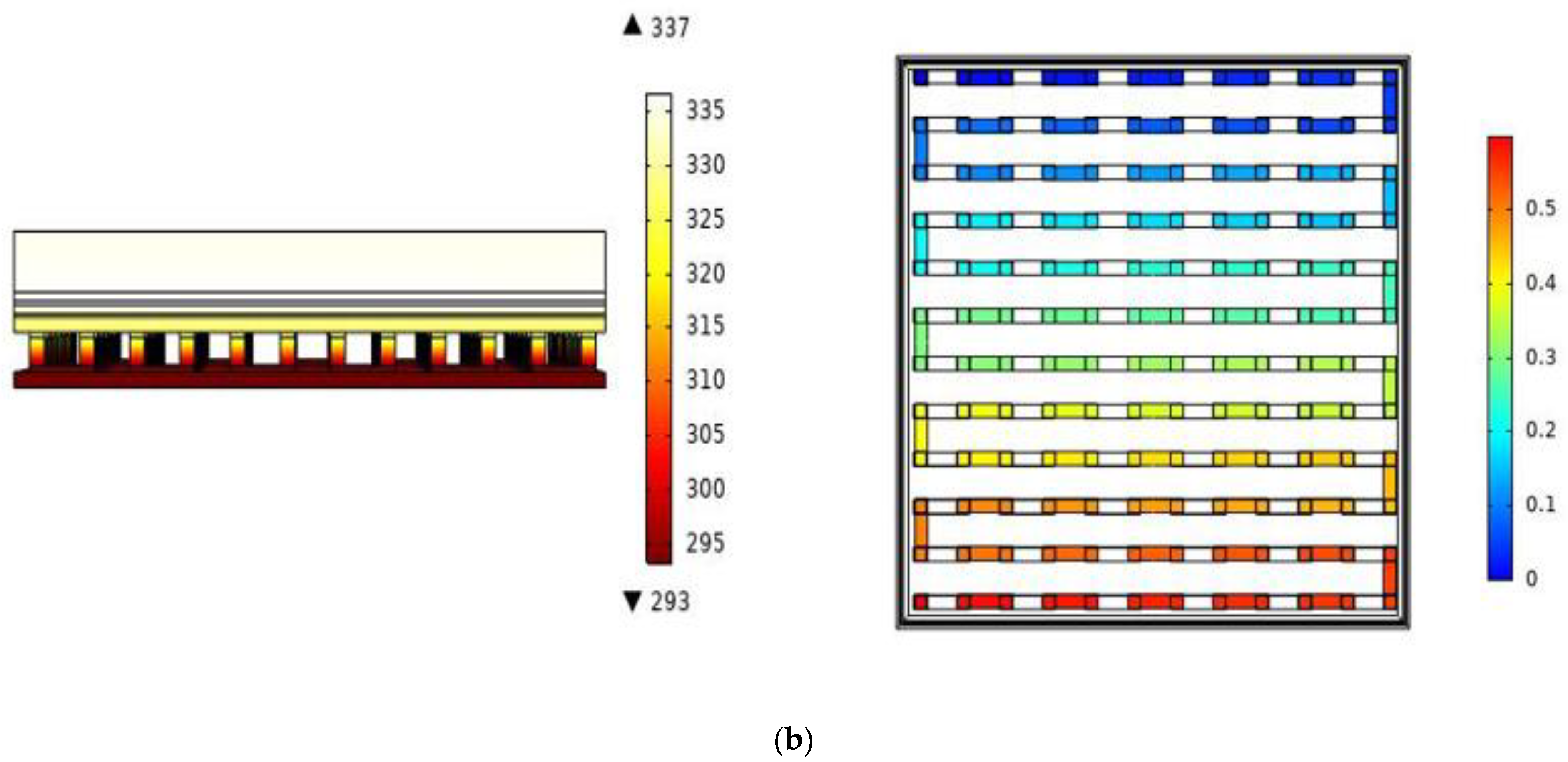
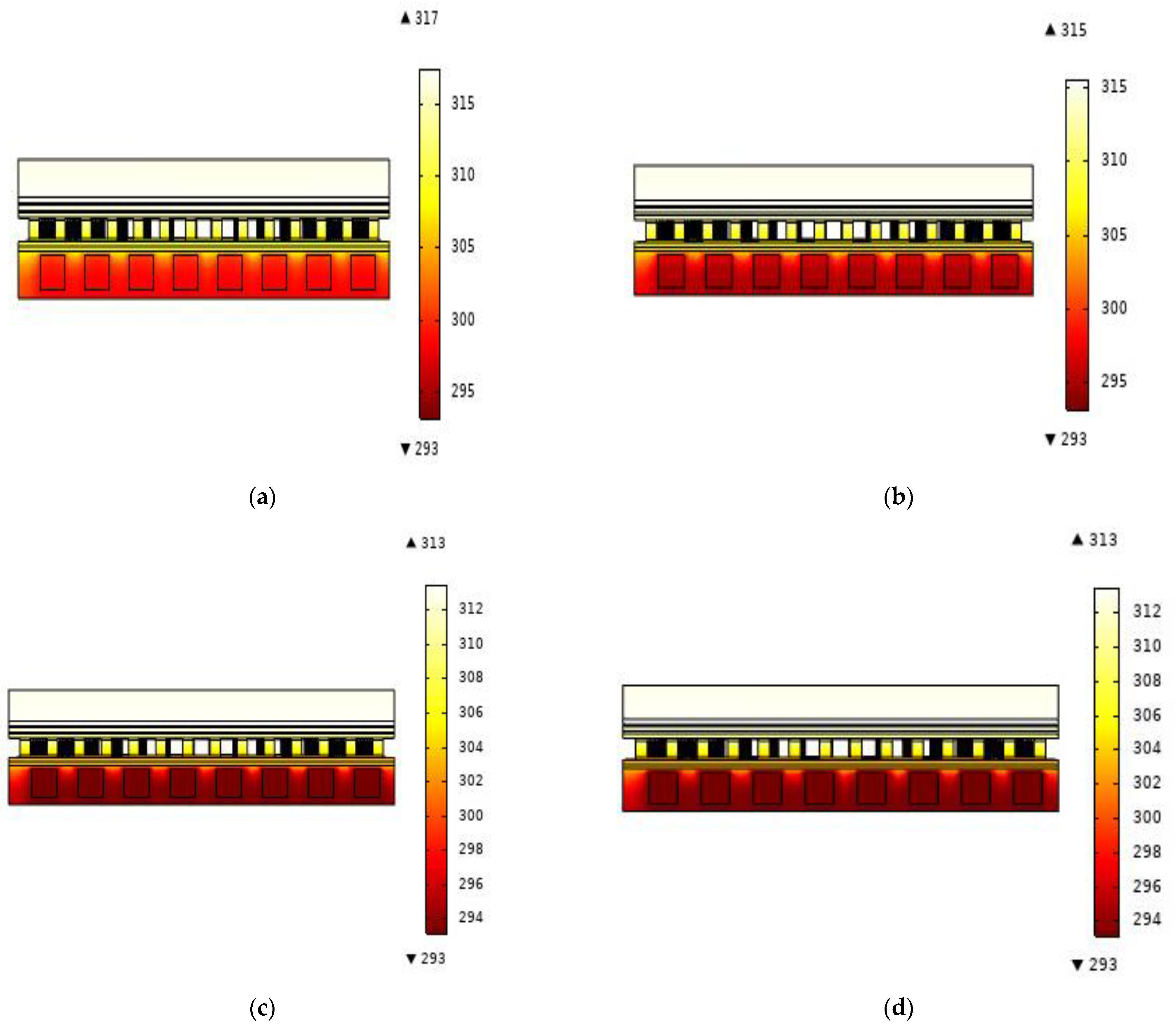


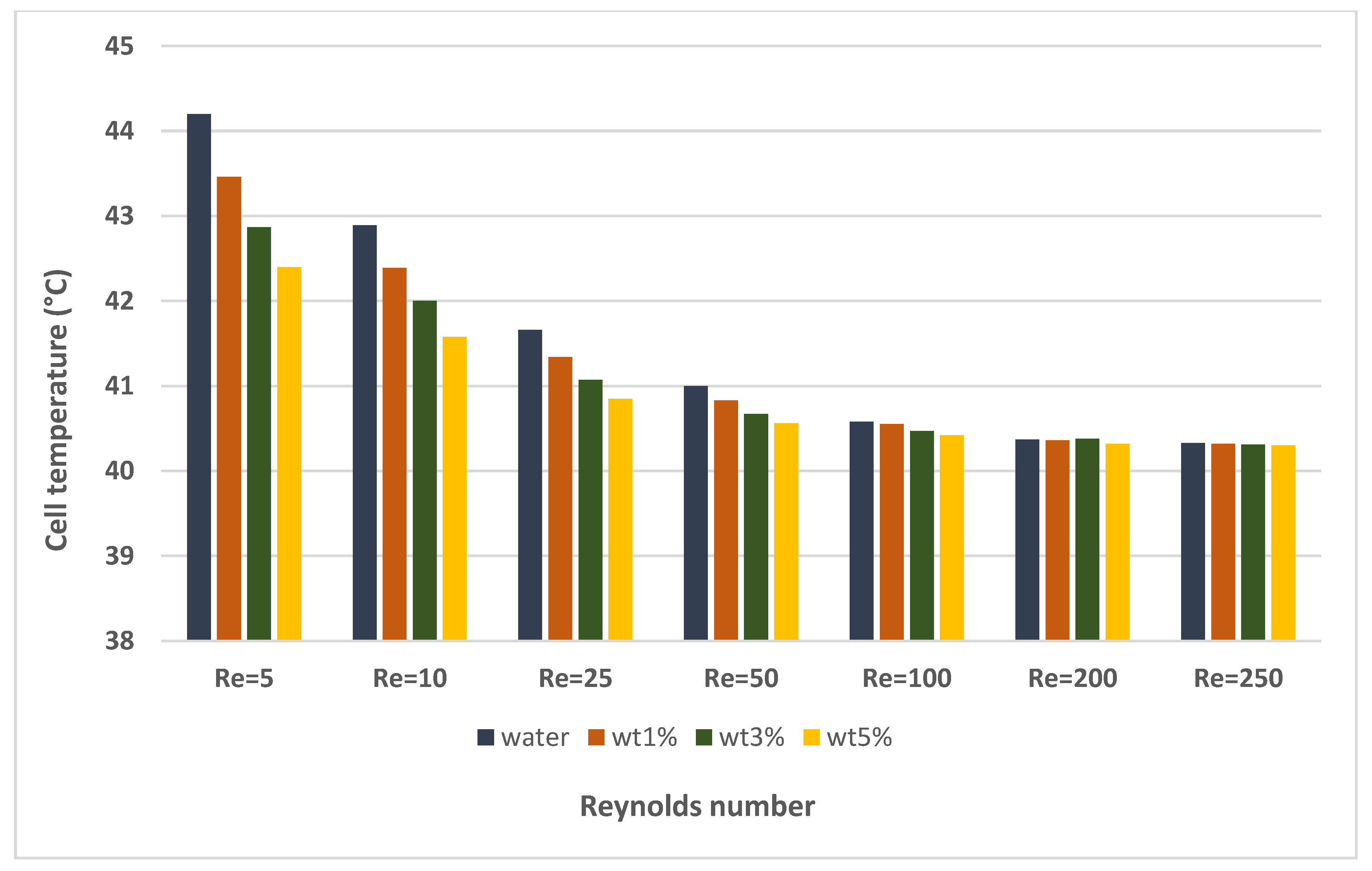
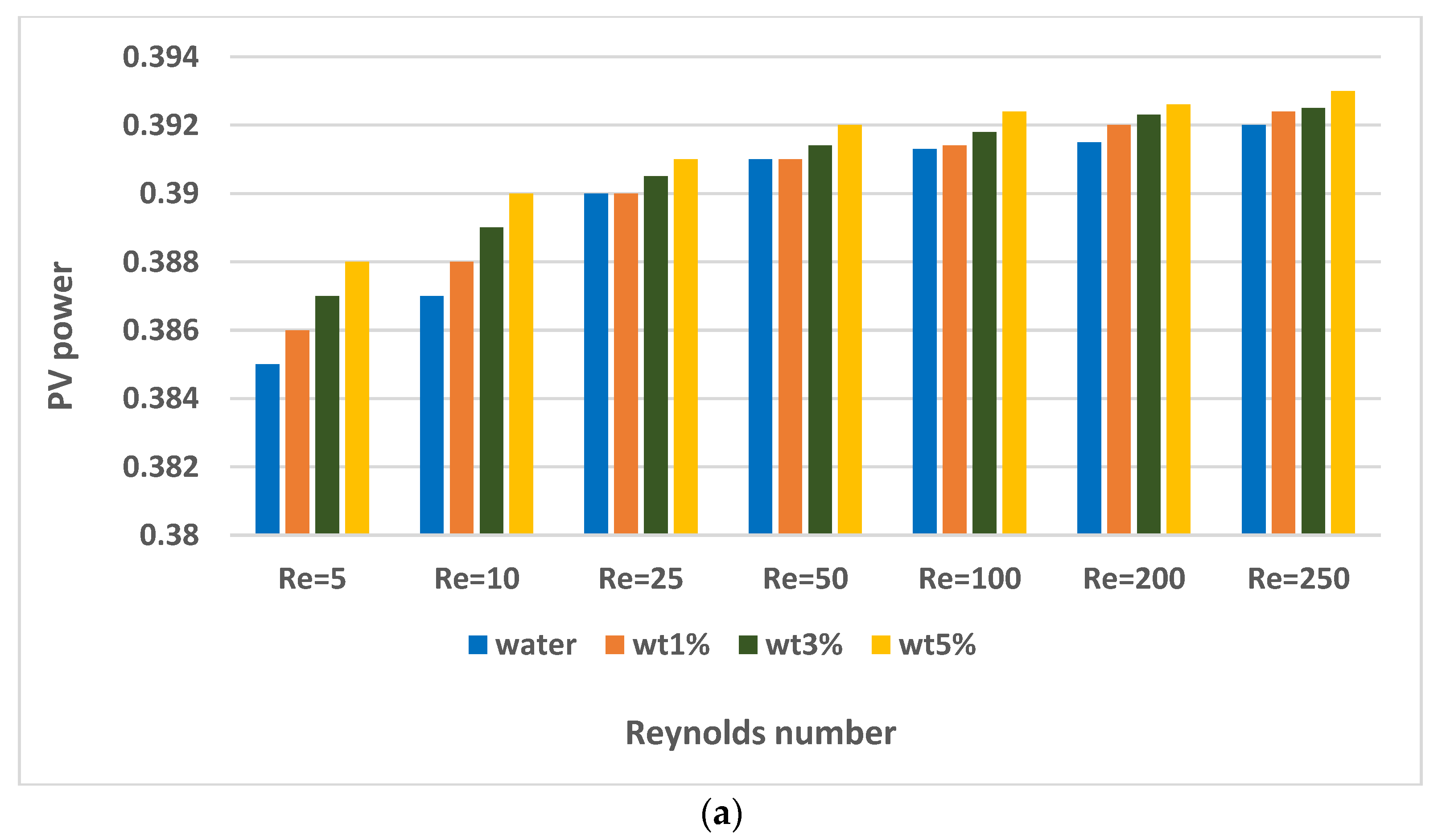
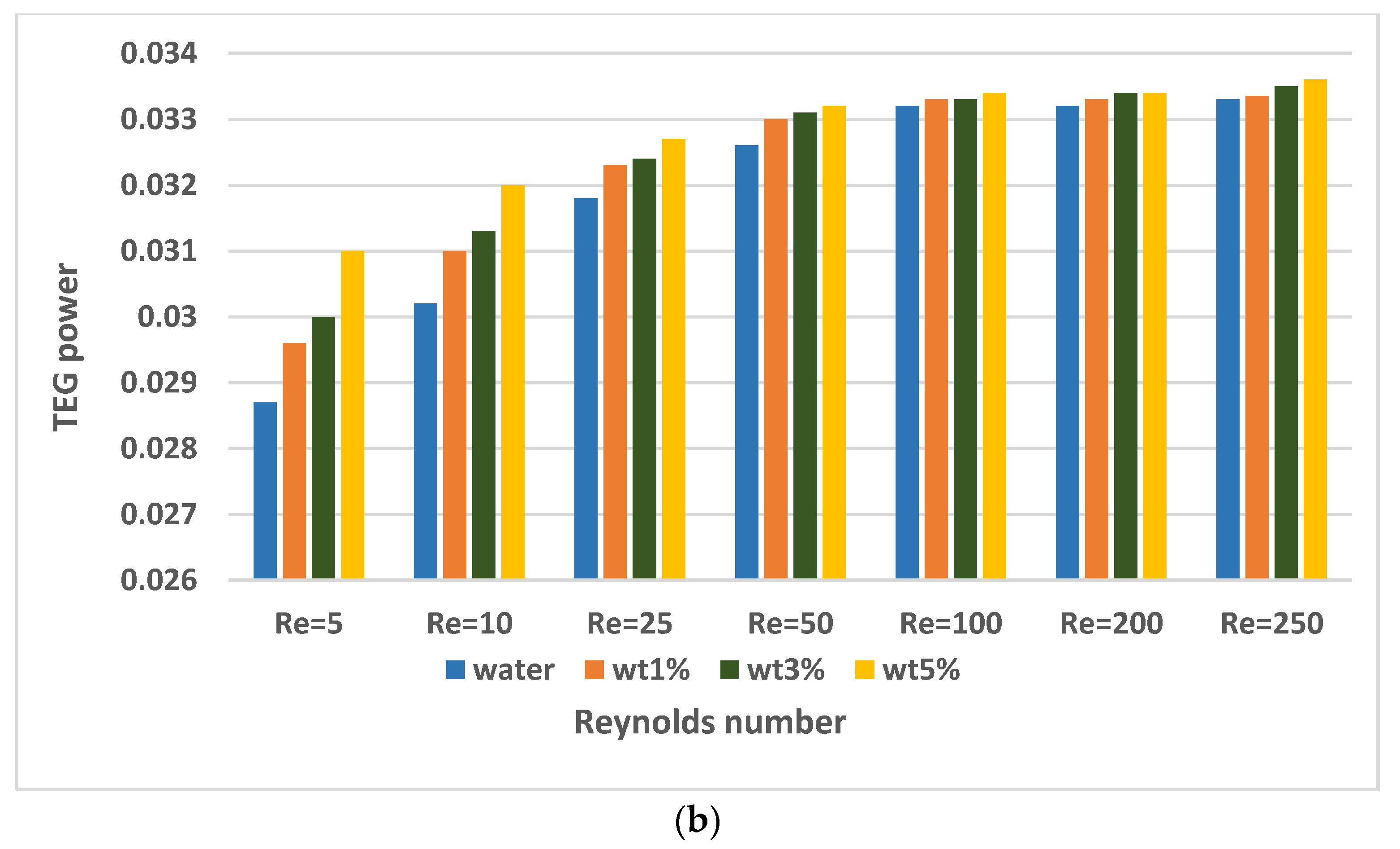


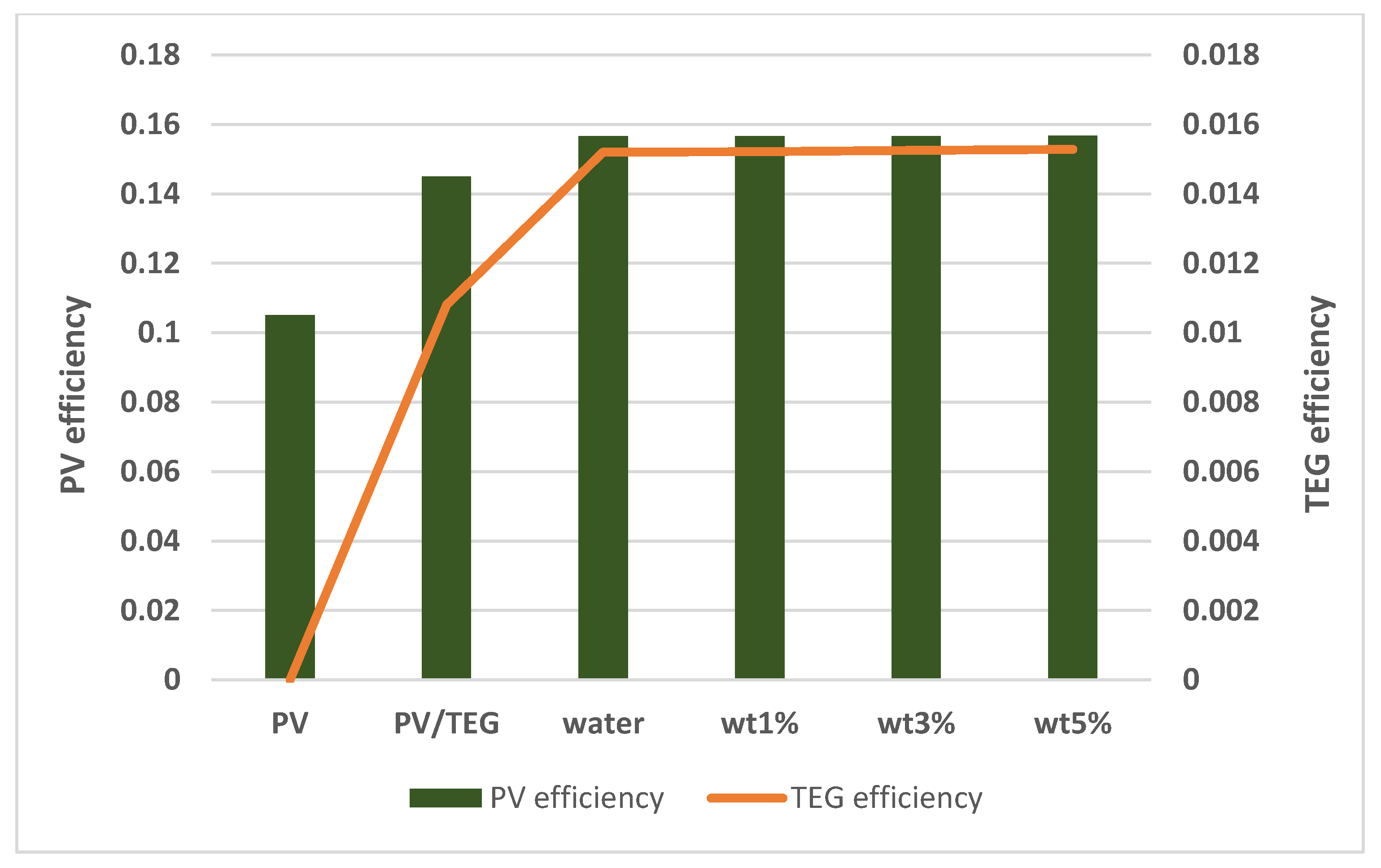





| Material | Thermal Conductivity | Specific Heat | Density |
|---|---|---|---|
| k (W/m.K) | (J/kg.K) | ||
| Glass | 2 | 500 | 2450 |
| Silicon cell | 130 | 2090 | 2330 |
| EVA | 0.311 | 2090 | 960 |
| TPT | 0.15 | 1250 | 1200 |
| Material | k (W/m.K) | (S/m) | S (V/K) | (J/kg.K) | |
|---|---|---|---|---|---|
| p-type | 1.6 | 0.8 | 2.1 | 154 | 7700 |
| n-type | 1.6 | 0.8 | −2.1 | 154 | 7700 |
| Cu | 400 | 5.9 | 6.5 | 385 | 8960 |
| 27 | 900 | 3900 |
| Component | Area | Height |
|---|---|---|
| Glass | 46 mm | 3.25 mm |
| EVA | 46 mm | 0.465 mm |
| Polycrystalline silicon | 46 mm | 0.185 mm |
| TPT | 46 mm | 0.185 mm |
| Thermoelectric leg | 1.25 mm | 1.55 mm |
| Conductor | 1.25 mm | 0.25 mm |
| Ceramic | 46 mm | 0.45 mm |
| Material | Emissivity | Absorptivity | Reflectivity | Transmissivity |
|---|---|---|---|---|
| Glass | 0.85 | 0.04 | 0.04 | 0.92 |
| Polycrystalline silicon | − | 0.9 | 0.08 | 0.02 |
| EVA | − | 0.08 | 0.02 | 0.9 |
| TPT | 0.92 | 0.128 | 0.86 | 0.012 |
| (%) | n | |
|---|---|---|
| 1 | 0.00230 | 0.830 |
| 3 | 0.00535 | 0.625 |
| 5 | 0.01020 | 0.460 |
| (%) | ||||
|---|---|---|---|---|
| 1 | 0.617 | 4148 | 1027 | |
| 3 | 0.648 | 4078 | 1085 | |
| 5 | 0.664 | 4012 | 1142 |
Disclaimer/Publisher’s Note: The statements, opinions and data contained in all publications are solely those of the individual author(s) and contributor(s) and not of MDPI and/or the editor(s). MDPI and/or the editor(s) disclaim responsibility for any injury to people or property resulting from any ideas, methods, instructions or products referred to in the content. |
© 2023 by the authors. Licensee MDPI, Basel, Switzerland. This article is an open access article distributed under the terms and conditions of the Creative Commons Attribution (CC BY) license (https://creativecommons.org/licenses/by/4.0/).
Share and Cite
Selimefendigil, F.; Okulu, D.; Öztop, H.F. Photovoltaic Thermal Management by Combined Utilization of Thermoelectric Generator and Power-Law-Nanofluid-Assisted Cooling Channel. Sustainability 2023, 15, 5424. https://doi.org/10.3390/su15065424
Selimefendigil F, Okulu D, Öztop HF. Photovoltaic Thermal Management by Combined Utilization of Thermoelectric Generator and Power-Law-Nanofluid-Assisted Cooling Channel. Sustainability. 2023; 15(6):5424. https://doi.org/10.3390/su15065424
Chicago/Turabian StyleSelimefendigil, Fatih, Damla Okulu, and Hakan F. Öztop. 2023. "Photovoltaic Thermal Management by Combined Utilization of Thermoelectric Generator and Power-Law-Nanofluid-Assisted Cooling Channel" Sustainability 15, no. 6: 5424. https://doi.org/10.3390/su15065424





